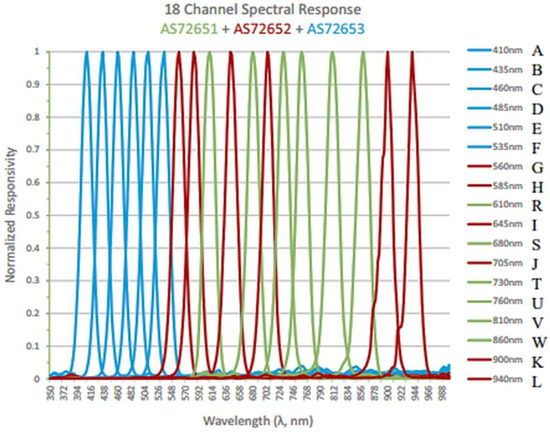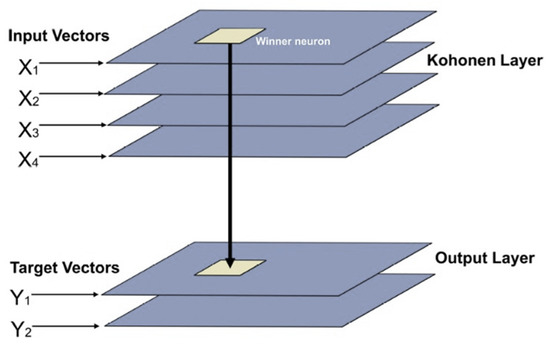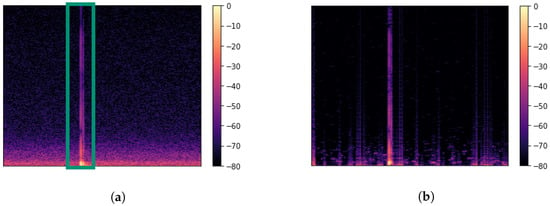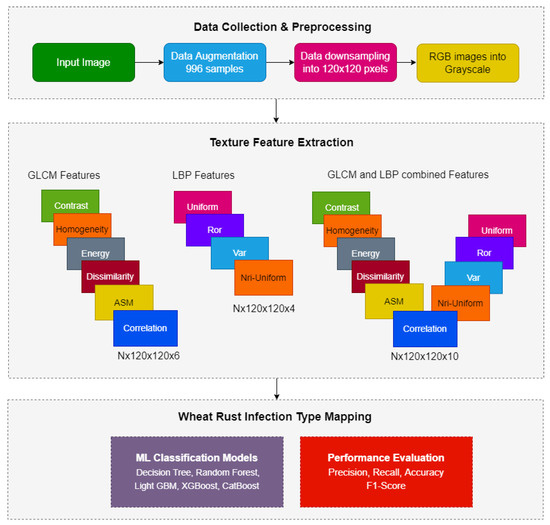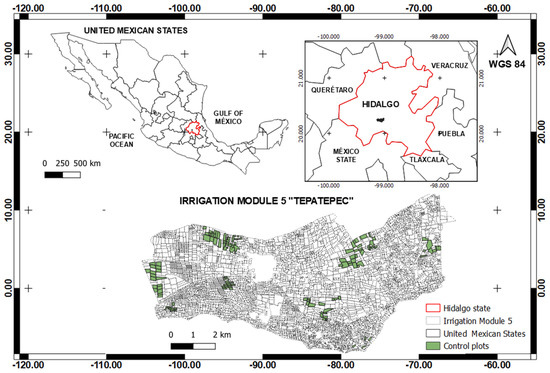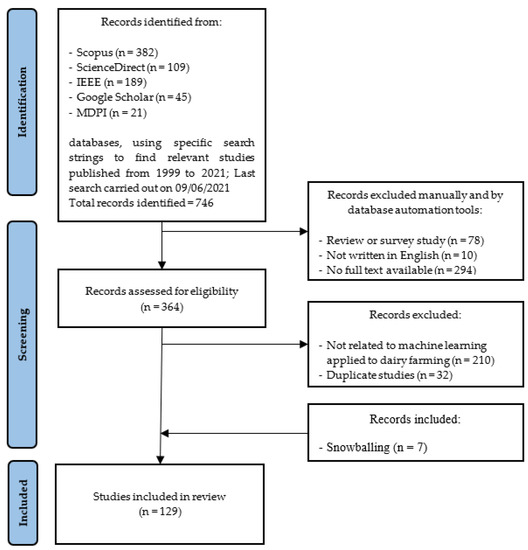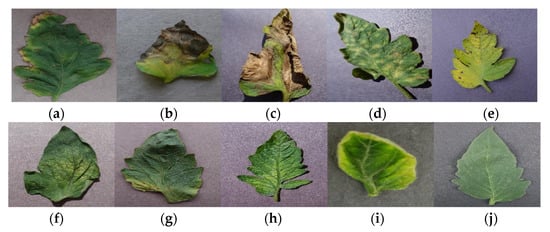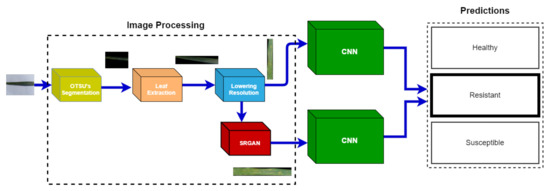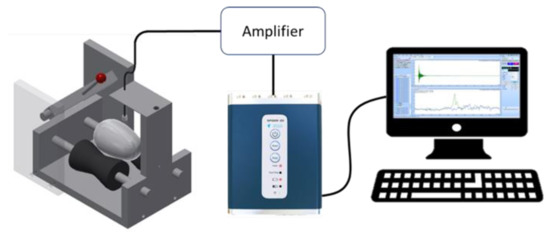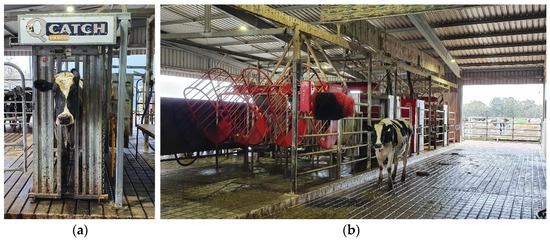Machine Learning in Agriculture
A topical collection in Sensors (ISSN 1424-8220). This collection belongs to the section "Physical Sensors".
Viewed by 44104
Share This Topical Collection
Editor
 Prof. Dr. Dimitrios Moshou
Prof. Dr. Dimitrios Moshou
 Prof. Dr. Dimitrios Moshou
Prof. Dr. Dimitrios Moshou
E-Mail
Website
Guest Editor
Head of Agricultural Engineering Laboratory, Faculty of Agriculture, Aristotle University of Thessaloniki (A.U.Th.), P.O. 275, 54124 Thessaloniki, Greece
Interests: remote sensing; multiscale fusion robotic agriculture; sensor networks; robotics; development of cognitive abilities; fusion of global and local cognition
Special Issues, Collections and Topics in MDPI journals
Topical Collection Information
Dear Colleagues,
With big data innovations and high-performance computing, machine learning has emerged to create new possibilities for data-intensive research in Agriculture and specially in the field of multi-disciplinary agro-technology. Applications relate to crop management, including yield prediction applications, remote and proximal sensing, crop phenotyping, disease detection, crop quality, weed detection, and species recognition; A significant field is the management of livestock, including animal protection and livestock production applications; water management; and soil management. Machine learning systems are benefiting from agriculture. Farm management systems are evolving into real-time artificial intelligence powered programs by applying machine learning to sensor data, providing rich suggestions and insights for far-reaching impact.
Prof. Dr. Dimitrios Moshou
Guest Editor
Manuscript Submission Information
Manuscripts should be submitted online at www.mdpi.com by registering and logging in to this website. Once you are registered, click here to go to the submission form. Manuscripts can be submitted until the deadline. All submissions that pass pre-check are peer-reviewed. Accepted papers will be published continuously in the journal (as soon as accepted) and will be listed together on the collection website. Research articles, review articles as well as short communications are invited. For planned papers, a title and short abstract (about 100 words) can be sent to the Editorial Office for announcement on this website.
Submitted manuscripts should not have been published previously, nor be under consideration for publication elsewhere (except conference proceedings papers). All manuscripts are thoroughly refereed through a single-blind peer-review process. A guide for authors and other relevant information for submission of manuscripts is available on the Instructions for Authors page. Sensors is an international peer-reviewed open access semimonthly journal published by MDPI.
Please visit the Instructions for Authors page before submitting a manuscript.
The Article Processing Charge (APC) for publication in this open access journal is 2600 CHF (Swiss Francs).
Submitted papers should be well formatted and use good English. Authors may use MDPI's
English editing service prior to publication or during author revisions.
Keywords
- Artificial intelligence
- deep learning
- neural networks
- generative adversarial networks
- computer vision
- sensor fusion
- multisensor systems
- sensor networks
- crop management
- water management
- soil management
- livestock management
- precision agriculture
- remote sensing, proximal sensing
- crop phenotyping
- crop pest detection
- crop disease detection
- robot sensors
Published Papers (11 papers)
Open AccessArticle
TinyML-Sensor for Shelf Life Estimation of Fresh Date Fruits
by
Ramasamy Srinivasagan, Maged Mohammed and Ali Alzahrani
Cited by 6 | Viewed by 2721
Abstract
Fresh dates have a limited shelf life and are susceptible to spoilage, which can lead to economic losses for producers and suppliers. The problem of accurate shelf life estimation for fresh dates is essential for various stakeholders involved in the production, supply, and
[...] Read more.
Fresh dates have a limited shelf life and are susceptible to spoilage, which can lead to economic losses for producers and suppliers. The problem of accurate shelf life estimation for fresh dates is essential for various stakeholders involved in the production, supply, and consumption of dates. Modified atmosphere packaging (MAP) is one of the essential methods that improves the quality and increases the shelf life of fresh dates by reducing the rate of ripening. Therefore, this study aims to apply fast and cost-effective non-destructive techniques based on machine learning (ML) to predict and estimate the shelf life of stored fresh date fruits under different conditions. Predicting and estimating the shelf life of stored date fruits is essential for scheduling them for consumption at the right time in the supply chain to benefit from the nutritional advantages of fresh dates. The study observed the physicochemical attributes of fresh date fruits, including moisture content, total soluble solids, sugar content, tannin content, pH, and firmness, during storage in a vacuum and MAP at 5 and 24
C every 7 days to determine the shelf life using a non-destructive approach. TinyML-compatible regression models were employed to predict the stages of fruit development during the storage period. The decrease in the shelf life of the fruits begins when they transition from the Khalal stage to the Rutab stage, and the shelf life ends when they start to spoil or ripen to the Tamr stage. Low-cost Visible–Near–Infrared (VisNIR) spectral sensors (AS7265x—multi-spectral) were used to capture the internal physicochemical attributes of the fresh fruit. Regression models were employed for shelf life estimation. The findings indicated that vacuum and modified atmosphere packaging with 20% CO
2 and N balance efficiently increased the shelf life of the stored fresh fruit to 53 days and 44 days, respectively, when maintained at 5
C. However, the shelf life decreased to 44 and 23 days when the vacuum and modified atmosphere packaging with 20% CO
2 and N balance were maintained at room temperature (24
C). Edge Impulse supports the training and deployment of models on low-cost microcontrollers, which can be used to predict real-time estimations of the shelf life of fresh dates using TinyML sensors.
Full article
►▼
Show Figures
Open AccessArticle
Diagnosis of Induced Resistance State in Tomato Using Artificial Neural Network Models Based on Supervised Self-Organizing Maps and Fluorescence Kinetics
by
Xanthoula Eirini Pantazi, Anastasia L. Lagopodi, Afroditi Alexandra Tamouridou, Nathalie Nephelie Kamou, Ioannis Giannakis, Georgios Lagiotis, Evangelia Stavridou, Panagiotis Madesis, Georgios Tziotzios, Konstantinos Dolaptsis and Dimitrios Moshou
Cited by 1 | Viewed by 1548
Abstract
The aim of this study was to develop three supervised self-organizing map (SOM) models for the automatic recognition of a systemic resistance state in plants after application of a resistance inducer. The pathosystem
Fusarium oxysporum f. sp.
radicis-lycopersici (FORL) + tomato was used.
[...] Read more.
The aim of this study was to develop three supervised self-organizing map (SOM) models for the automatic recognition of a systemic resistance state in plants after application of a resistance inducer. The pathosystem
Fusarium oxysporum f. sp.
radicis-lycopersici (FORL) + tomato was used. The inorganic, defense inducer, Acibenzolar-S-methyl (benzo-[1,2,3]-thiadiazole-7-carbothioic acid-S-methyl ester, ASM), reported to induce expression of defense genes in tomato, was applied to activate the defense mechanisms in the plant. A handheld fluorometer, FluorPen FP 100-MAX-LM by SCI, was used to assess the fluorescence kinetics response of the induced resistance in tomato plants. To achieve recognition of resistance induction, three models of supervised SOMs, namely SKN, XY-F, and CPANN, were used to classify fluorescence kinetics data, in order to determine the induced resistance condition in tomato plants. To achieve this, a parameterization of fluorescence kinetics curves was developed corresponding to fluorometer variables of the Kautsky Curves. SKN was the best supervised SOM, achieving 97.22% to 100% accuracy. Gene expression data were used to confirm the accuracy of the supervised SOMs.
Full article
►▼
Show Figures
Open AccessArticle
Interactive Deep Learning for Shelf Life Prediction of Muskmelons Based on an Active Learning Approach
by
Dominique Albert-Weiss and Ahmad Osman
Cited by 11 | Viewed by 2949
Abstract
A pivotal topic in agriculture and food monitoring is the assessment of the quality and ripeness of agricultural products by using non-destructive testing techniques. Acoustic testing offers a rapid in situ analysis of the state of the agricultural good, obtaining global information of
[...] Read more.
A pivotal topic in agriculture and food monitoring is the assessment of the quality and ripeness of agricultural products by using non-destructive testing techniques. Acoustic testing offers a rapid in situ analysis of the state of the agricultural good, obtaining global information of its interior. While deep learning (DL) methods have outperformed state-of-the-art benchmarks in various applications, the reason for lacking adaptation of DL algorithms such as convolutional neural networks (CNNs) can be traced back to its high data inefficiency and the absence of annotated data. Active learning is a framework that has been heavily used in machine learning when the labelled instances are scarce or cumbersome to obtain. This is specifically of interest when the DL algorithm is highly uncertain about the label of an instance. By allowing the human-in-the-loop for guidance, a continuous improvement of the DL algorithm based on a sample efficient manner can be obtained. This paper seeks to study the applicability of active learning when grading ‘Galia’ muskmelons based on its shelf life. We propose
k-Determinantal Point Processes (
k-DPP), which is a purely diversity-based method that allows to take influence on the exploration within the feature space based on the chosen subset
k. While getting coequal results to uncertainty-based approaches when
k is large, we simultaneously obtain a better exploration of the data distribution. While the implementation based on eigendecomposition takes up a runtime of
, this can further be reduced to
based on rejection sampling. We suggest the use of diversity-based acquisition when only a few labelled samples are available, allowing for better exploration while counteracting the disadvantage of missing the training objective in uncertainty-based methods following a greedy fashion.
Full article
►▼
Show Figures
Open AccessArticle
Wheat Yellow Rust Disease Infection Type Classification Using Texture Features
by
Uferah Shafi, Rafia Mumtaz, Ihsan Ul Haq, Maryam Hafeez, Naveed Iqbal, Arslan Shaukat, Syed Mohammad Hassan Zaidi and Zahid Mahmood
Cited by 18 | Viewed by 4701
Abstract
Wheat is a staple crop of Pakistan that covers almost 40% of the cultivated land and contributes almost 3% in the overall Gross Domestic Product (GDP) of Pakistan. However, due to increasing seasonal variation, it was observed that wheat is majorly affected by
[...] Read more.
Wheat is a staple crop of Pakistan that covers almost 40% of the cultivated land and contributes almost 3% in the overall Gross Domestic Product (GDP) of Pakistan. However, due to increasing seasonal variation, it was observed that wheat is majorly affected by rust disease, particularly in rain-fed areas. Rust is considered the most harmful fungal disease for wheat, which can cause reductions of 20–30% in wheat yield. Its capability to spread rapidly over time has made its management most challenging, becoming a major threat to food security. In order to counter this threat, precise detection of wheat rust and its infection types is important for minimizing yield losses. For this purpose, we have proposed a framework for classifying wheat yellow rust infection types using machine learning techniques. First, an image dataset of different yellow rust infections was collected using mobile cameras. Six Gray Level Co-occurrence Matrix (GLCM) texture features and four Local Binary Patterns (LBP) texture features were extracted from grayscale images of the collected dataset. In order to classify wheat yellow rust disease into its three classes (healthy, resistant, and susceptible), Decision Tree, Random Forest, Light Gradient Boosting Machine (LightGBM), Extreme Gradient Boosting (XGBoost), and CatBoost were used with (i) GLCM, (ii) LBP, and (iii) combined GLCM-LBP texture features. The results indicate that CatBoost outperformed on GLCM texture features with an accuracy of 92.30%. This accuracy can be further improved by scaling up the dataset and applying deep learning models. The development of the proposed study could be useful for the agricultural community for the early detection of wheat yellow rust infection and assist in taking remedial measures to contain crop yield.
Full article
►▼
Show Figures
Open AccessArticle
Recognition of Maize Phenology in Sentinel Images with Machine Learning
by
Alvaro Murguia-Cozar, Antonia Macedo-Cruz, Demetrio Salvador Fernandez-Reynoso and Jorge Arturo Salgado Transito
Viewed by 2856
Abstract
The scarcity of water for agricultural use is a serious problem that has increased due to intense droughts, poor management, and deficiencies in the distribution and application of the resource. The monitoring of crops through satellite image processing and the application of machine
[...] Read more.
The scarcity of water for agricultural use is a serious problem that has increased due to intense droughts, poor management, and deficiencies in the distribution and application of the resource. The monitoring of crops through satellite image processing and the application of machine learning algorithms are technological strategies with which developed countries tend to implement better public policies regarding the efficient use of water. The purpose of this research was to determine the main indicators and characteristics that allow us to discriminate the phenological stages of maize crops (
Zea mays L.) in Sentinel 2 satellite images through supervised classification models. The training data were obtained by monitoring cultivated plots during an agricultural cycle. Indicators and characteristics were extracted from 41 Sentinel 2 images acquired during the monitoring dates. With these images, indicators of texture, vegetation, and colour were calculated to train three supervised classifiers: linear discriminant (LD), support vector machine (SVM), and k-nearest neighbours (kNN) models. It was found that 45 of the 86 characteristics extracted contributed to maximizing the accuracy by stage of development and the overall accuracy of the trained classification models. The characteristics of the Moran’s
I local indicator of spatial association (LISA) improved the accuracy of the classifiers when applied to the L*a*b* colour model and to the near-infrared (NIR) band. The local binary pattern (LBP) increased the accuracy of the classification when applied to the red, green, blue (RGB) and NIR bands. The colour ratios, leaf area index (LAI), RGB colour model, L*a*b* colour space, LISA, and LBP extracted the most important intrinsic characteristics of maize crops with regard to classifying the phenological stages of the maize cultivation. The quadratic SVM model was the best classifier of maize crop phenology, with an overall accuracy of 82.3%.
Full article
►▼
Show Figures
Open AccessReview
Over 20 Years of Machine Learning Applications on Dairy Farms: A Comprehensive Mapping Study
by
Philip Shine and Michael D. Murphy
Cited by 17 | Viewed by 4517
Abstract
Machine learning applications are becoming more ubiquitous in dairy farming decision support applications in areas such as feeding, animal husbandry, healthcare, animal behavior, milking and resource management. Thus, the objective of this mapping study was to collate and assess studies published in journals
[...] Read more.
Machine learning applications are becoming more ubiquitous in dairy farming decision support applications in areas such as feeding, animal husbandry, healthcare, animal behavior, milking and resource management. Thus, the objective of this mapping study was to collate and assess studies published in journals and conference proceedings between 1999 and 2021, which applied machine learning algorithms to dairy farming-related problems to identify trends in the geographical origins of data, as well as the algorithms, features and evaluation metrics and methods used. This mapping study was carried out in line with PRISMA guidelines, with six pre-defined research questions (RQ) and a broad and unbiased search strategy that explored five databases. In total, 129 publications passed the pre-defined selection criteria, from which relevant data required to answer each RQ were extracted and analyzed. This study found that Europe (43% of studies) produced the largest number of publications (RQ1), while the largest number of articles were published in the Computers and Electronics in Agriculture journal (21%) (RQ2). The largest number of studies addressed problems related to the physiology and health of dairy cows (32%) (RQ3), while the most frequently employed feature data were derived from sensors (48%) (RQ4). The largest number of studies employed tree-based algorithms (54%) (RQ5), while RMSE (56%) (regression) and accuracy (77%) (classification) were the most frequently employed metrics used, and hold-out cross-validation (39%) was the most frequently employed evaluation method (RQ6). Since 2018, there has been more than a sevenfold increase in the number of studies that focused on the physiology and health of dairy cows, compared to almost a threefold increase in the overall number of publications, suggesting an increased focus on this subdomain. In addition, a fivefold increase in the number of publications that employed neural network algorithms was identified since 2018, in comparison to a threefold increase in the use of both tree-based algorithms and statistical regression algorithms, suggesting an increasing utilization of neural network-based algorithms.
Full article
►▼
Show Figures
Open AccessArticle
Early Detection and Classification of Tomato Leaf Disease Using High-Performance Deep Neural Network
by
Naresh K. Trivedi, Vinay Gautam, Abhineet Anand, Hani Moaiteq Aljahdali, Santos Gracia Villar, Divya Anand, Nitin Goyal and Seifedine Kadry
Cited by 152 | Viewed by 9757
Abstract
Tomato is one of the most essential and consumable crops in the world. Tomatoes differ in quantity depending on how they are fertilized. Leaf disease is the primary factor impacting the amount and quality of crop yield. As a result, it is critical
[...] Read more.
Tomato is one of the most essential and consumable crops in the world. Tomatoes differ in quantity depending on how they are fertilized. Leaf disease is the primary factor impacting the amount and quality of crop yield. As a result, it is critical to diagnose and classify these disorders appropriately. Different kinds of diseases influence the production of tomatoes. Earlier identification of these diseases would reduce the disease’s effect on tomato plants and enhance good crop yield. Different innovative ways of identifying and classifying certain diseases have been used extensively. The motive of work is to support farmers in identifying early-stage diseases accurately and informing them about these diseases. The Convolutional Neural Network (CNN) is used to effectively define and classify tomato diseases. Google Colab is used to conduct the complete experiment with a dataset containing 3000 images of tomato leaves affected by nine different diseases and a healthy leaf. The complete process is described: Firstly, the input images are preprocessed, and the targeted area of images are segmented from the original images. Secondly, the images are further processed with varying hyper-parameters of the CNN model. Finally, CNN extracts other characteristics from pictures like colors, texture, and edges, etc. The findings demonstrate that the proposed model predictions are 98.49% accurate.
Full article
►▼
Show Figures
Open AccessCommunication
Super Resolution Generative Adversarial Network (SRGANs) for Wheat Stripe Rust Classification
by
Muhammad Hassan Maqsood, Rafia Mumtaz, Ihsan Ul Haq, Uferah Shafi, Syed Mohammad Hassan Zaidi and Maryam Hafeez
Cited by 9 | Viewed by 3441
Abstract
Wheat yellow rust is a common agricultural disease that affects the crop every year across the world. The disease not only negatively impacts the quality of the yield but the quantity as well, which results in adverse impact on economy and food supply.
[...] Read more.
Wheat yellow rust is a common agricultural disease that affects the crop every year across the world. The disease not only negatively impacts the quality of the yield but the quantity as well, which results in adverse impact on economy and food supply. It is highly desired to develop methods for fast and accurate detection of yellow rust in wheat crop; however, high-resolution images are not always available which hinders the ability of trained models in detection tasks. The approach presented in this study harnesses the power of super-resolution generative adversarial networks (SRGAN) for upsampling the images before using them to train deep learning models for the detection of wheat yellow rust. After preprocessing the data for noise removal, SRGANs are used for upsampling the images to increase their resolution which helps convolutional neural network (CNN) in learning high-quality features during training. This study empirically shows that SRGANs can be used effectively to improve the quality of images and produce significantly better results when compared with models trained using low-resolution images. This is evident from the results obtained on upsampled images, i.e., 83% of overall test accuracy, which are substantially better than the overall test accuracy achieved for low-resolution images, i.e., 75%. The proposed approach can be used in other real-world scenarios where images are of low resolution due to the unavailability of high-resolution camera in edge devices.
Full article
►▼
Show Figures
Open AccessCommunication
Duck Eggshell Crack Detection by Nondestructive Sonic Measurement and Analysis
by
Chia-Chun Lai, Cheng-Han Li, Ko-Jung Huang and Ching-Wei Cheng
Cited by 4 | Viewed by 2753
Abstract
Duck eggs are a good source of essential nutrients for the human body. However, transportation, processing, and handling can easily cause cracks in the eggshells. These cracks can lead to microbial contamination, reducing the shelf life and compromising food safety. In this study,
[...] Read more.
Duck eggs are a good source of essential nutrients for the human body. However, transportation, processing, and handling can easily cause cracks in the eggshells. These cracks can lead to microbial contamination, reducing the shelf life and compromising food safety. In this study, a method for the nondestructive testing of cracks in duck eggshells was developed. First, the acoustic emission signals of intact and cracked eggshells were measured, and the most significant frequency features were selected to establish a calibration curve for cracked eggshells. Logistic regression using the frequency features was then adopted to predict intact and cracked eggshells. Then, we establish a set of optimal regression models and used independent samples for verification. The overall accuracy rates of the calibration and prediction models using five frequencies of bandwidth (1500, 5000, 6000, 8500, and 10,000 Hz) were 89.7% and 87.6%, respectively. Sound measurement enables a simple and quantitative method for duck egg crack detection and classification. This nondestructive and cost-effective method can be used for duck egg quality screening and can be integrated into duck egg processing machinery.
Full article
►▼
Show Figures
Open AccessArticle
Central Object Segmentation by Deep Learning to Continuously Monitor Fruit Growth through RGB Images
by
Motohisa Fukuda, Takashi Okuno and Shinya Yuki
Cited by 8 | Viewed by 2261
Abstract
Monitoring fruit growth is useful when estimating final yields in advance and predicting optimum harvest times. However, observing fruit all day at the farm via RGB images is not an easy task because the light conditions are constantly changing. In this paper, we
[...] Read more.
Monitoring fruit growth is useful when estimating final yields in advance and predicting optimum harvest times. However, observing fruit all day at the farm via RGB images is not an easy task because the light conditions are constantly changing. In this paper, we present CROP (Central Roundish Object Painter). The method involves image segmentation by deep learning, and the architecture of the neural network is a deeper version of U-Net. CROP identifies different types of central roundish fruit in an RGB image in varied light conditions, and creates a corresponding mask. Counting the mask pixels gives the relative two-dimensional size of the fruit, and in this way, time-series images may provide a non-contact means of automatically monitoring fruit growth. Although our measurement unit is different from the traditional one (length), we believe that shape identification potentially provides more information. Interestingly, CROP can have a more general use, working even for some other roundish objects. For this reason, we hope that CROP and our methodology yield big data to promote scientific advancements in horticultural science and other fields.
Full article
►▼
Show Figures
Open AccessArticle
Biometric Physiological Responses from Dairy Cows Measured by Visible Remote Sensing Are Good Predictors of Milk Productivity and Quality through Artificial Intelligence
by
Sigfredo Fuentes, Claudia Gonzalez Viejo, Eden Tongson, Nir Lipovetzky and Frank R. Dunshea
Cited by 14 | Viewed by 3684
Abstract
New and emerging technologies, especially those based on non-invasive video and thermal infrared cameras, can be readily tested on robotic milking facilities. In this research, implemented non-invasive computer vision methods to estimate cow’s heart rate, respiration rate, and abrupt movements captured using RGB
[...] Read more.
New and emerging technologies, especially those based on non-invasive video and thermal infrared cameras, can be readily tested on robotic milking facilities. In this research, implemented non-invasive computer vision methods to estimate cow’s heart rate, respiration rate, and abrupt movements captured using RGB cameras and machine learning modelling to predict eye temperature, milk production and quality are presented. RGB and infrared thermal videos (IRTV) were acquired from cows using a robotic milking facility. Results from 102 different cows with replicates (
n = 150) showed that an artificial neural network (ANN) model using only inputs from RGB cameras presented high accuracy (R = 0.96) in predicting eye temperature (°C), using IRTV as ground truth, daily milk productivity (kg-milk-day
−1), cow milk productivity (kg-milk-cow
−1), milk fat (%) and milk protein (%) with no signs of overfitting. The ANN model developed was deployed using an independent 132 cow samples obtained on different days, which also rendered high accuracy and was similar to the model development (R = 0.93). This model can be easily applied using affordable RGB camera systems to obtain all the proposed targets, including eye temperature, which can also be used to model animal welfare and biotic/abiotic stress. Furthermore, these models can be readily deployed in conventional dairy farms.
Full article
►▼
Show Figures






